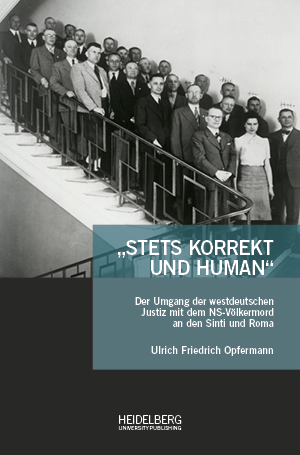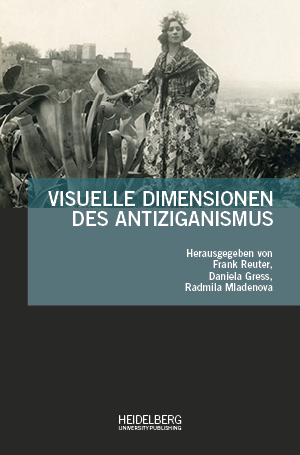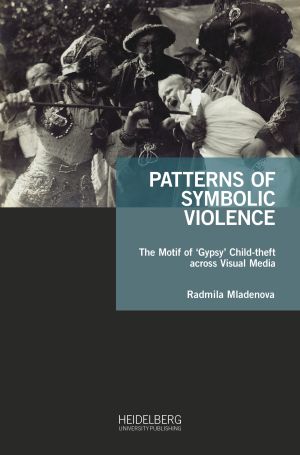Antiziganismusforschung interdisziplinär
Schriftenreihe der Forschungsstelle Antiziganismus
Antiziganismusforschung interdisziplinär gibt Einblicke in ein noch junges, aber dynamisches Forschungsfeld, das unterschiedliche methodische Zugänge erfordert. Sowohl bereits etablierte Forscherinnen und Forscher wie Nachwuchswissenschaftlerinnen und -wissenschaftler erhalten die Möglichkeit, neue Forschungsergebnisse in englischer oder deutscher Sprache zu publizieren. Die Reihe zielt darauf ab, die Antiziganismusforschung stärker im akademischen Diskurs zu verankern und Institutionen wie Forschende zusammenzuführen, kurz: sie will Impulsgeber für die weitere Grundlagenarbeit sein.
Als erste Fachinstitution ihrer Art ist die Forschungsstelle Antiziganismus seit Juli 2017 am Historischen Seminar der Universität Heidelberg angesiedelt; sie wird dauerhaft vom Land Baden-Württemberg gefördert. Die dort tätigen Wissenschaftlerinnen und Wissenschaftler setzen sich mit den vielfältigen Erscheinungsformen des Antiziganismus – verstanden als eine spezifische Form des Rassismus gegen Sinti, Roma und andere als „Zigeuner“ stigmatisierte Gruppen oder Individuen – auseinander. Das Erkenntnisinteresse gilt insbesondere den Mechanismen der antiziganistischen Vorurteilsbildung und deren unterschiedlichen Funktionen in den europäischen Gesellschaften von der Frühen Neuzeit bis in die Gegenwart.
Antiziganismusforschung interdisziplinär gibt Einblicke in ein noch junges, aber dynamisches Forschungsfeld, das unterschiedliche methodische Zugänge erfordert. Sowohl bereits etablierte Forscherinnen und Forscher wie Nachwuchswissenschaftlerinnen und -wissenschaftler erhalten die Möglichkeit, neue Forschungsergebnisse in englischer oder deutscher Sprache zu publizieren. Die Reihe zielt darauf ab, die Antiziganismusforschung stärker im akademischen Diskurs zu verankern und Institutionen wie Forschende zusammenzuführen, kurz: sie will Impulsgeber für die weitere Grundlagenarbeit sein.
Als erste Fachinstitution ihrer Art ist die Forschungsstelle Antiziganismus seit Juli 2017 am Historischen Seminar der Universität Heidelberg angesiedelt; sie wird dauerhaft vom Land Baden-Württemberg gefördert. Die dort tätigen Wissenschaftlerinnen und Wissenschaftler setzen sich mit den vielfältigen Erscheinungsformen des Antiziganismus – verstanden als eine spezifische Form des Rassismus gegen Sinti, Roma und andere als „Zigeuner“ stigmatisierte Gruppen oder Individuen – auseinander. Das Erkenntnisinteresse gilt insbesondere den Mechanismen der antiziganistischen Vorurteilsbildung und deren unterschiedlichen Funktionen in den europäischen Gesellschaften von der Frühen Neuzeit bis in die Gegenwart.
Antiziganismusforschung interdisziplinär
Schriftenreihe der Forschungsstelle Antiziganismus
Reihenherausgeber
- Prof. Dr. Tanja Penter, Heidelberg
- Dr. Frank Reuter, Heidelberg
- Daniela Gress, M.A., Heidelberg
Die Reihe wurde von Prof. Dr. Edgar Wolfrum mitbegründet.
Bisher erschienen
Antiziganismus im baden-württembergischen Staatsapparat 1945–1970
Der Zusammenbruch des NS-Regimes bedeutete für die in Deutschland lebenden Sinti und Roma noch nicht das Ende von Unterdrückung und Ausgrenzung. Auch nach 1945 waren sie mit Diskriminierung konfrontiert, denn insbesondere auf staatlicher Ebene waren antiziganistische Vorurteilsstrukturen weiterhin handlungsleitend. Mit Blick auf die drei Themenschwerpunkte Entschädigung, Gesetzgebung und juristische Ahndung nationalsozialistischer Gewaltverbrechen fokussiert sich die vorliegende Studie auf den baden-württembergischen Staatsapparat und seine Minderheitenpolitik bis in die 1970er-Jahre. Im Vordergrund steht der Umgang der Behörden mit den überlebenden Sinti und Roma sowie deren Perspektive auf ihre staatlichen Verfolgungs- und Vernichtungserfahrungen im Nationalsozialismus.
Counterstrategies to the Antigypsy Gaze
Wie sich dem Antiziganismus im Film begegnen lässt, ist Thema des vorliegenden Sammelbandes. Ziel ist es, den Fokus weg von der Antiziganismuskritik zu verlagern und die Diskussion über die künstlerischen Gegenstrategien zum Antiziganismus zu eröffnen, die die Notwendigkeit intertextueller, transkultureller und transmedialer Ansätze bei der Analyse hervorhebt. Die Beiträge stellen die Anwendbarkeit der Forschungsergebnisse in den Vordergrund und bieten eine breite Palette an Beispielen, die für Filmemacher und Fachleute aus der Filmindustrie nützlich sein könnten.
Der Band dokumentiert die Fallstudien des internationalen Workshops “Artistic Alternatives to the Antigypsy Gaze“, der 2021 in Heidelberg stattfand.
„Stets korrekt und human“: Der Umgang der westdeutschen Justiz mit dem NS-Völkermord an den Sinti und Roma
Das Buch gibt erstmals einen systematischen Überblick zu einem bislang vernachlässigten Bereich der justiziellen Aufarbeitung des NS-Systems: dem Umgang mit den Verbrechen an den Sinti und Roma in westdeutschen NSG-Verfahren unter Einbezug des Tatraums Osteuropa. Die akribisch recherchierte Studie stellt zahlreiche Verfahren vor. Sie informiert über die rechtlichen Voraussetzungen des westdeutschen justiziellen Sonderwegs, zeichnet den Verfahrensgang nach und fragt nach den Rollen der Beschuldigten und Zeugen sowie des Justizpersonals. Im Mittelpunkt steht das als Großverfahren neben dem ersten Auschwitz-Prozess geplante Sammelverfahren zum „Zigeunerkomplex“ (1958–1970), das entgegen seinem Anspruch kaum Resonanz entfaltete und heute weitgehend vergessen ist.
The ‘White’ Mask and the ‘Gypsy’ Mask in Film
Die Studie widmet sich einem in der Filmwissenschaft bislang vernachlässigten Thema: dem ‚Zigeuner‘-Phantasma auf der Kinoleinwand. Sie verbindet die Rekonstruktion der Geschichte der ‚Zigeuner‘-Darstellungen im Film seit den Anfängen des Mediums mit einer systematischen filmtheoretischen Verortung ihrer ästhetischen und gesellschaftlichen Funktion. Auf der Grundlage von über 150 Werken aus dem europäischen und US-amerikanischen Kino wird aufgezeigt, dass den ,Zigeuner‘-Spielfilmproduktionen unabhängig von Ort und Zeit ihrer Entstehung das Grundgerüst einer ,ethno-rassischen‘ Maskerade gemeinsam ist. Damit erweitert die Autorin die bisherigen, auf das Gebiet der Literatur konzentrierten Forschungen um ein weiteres Medium, den Film, und erschließt neue Dimensionen des (populär-)kulturellen Antiziganismus.
Visuelle Dimensionen des Antiziganismus
Visuelle Medien spielen seit der Frühen Neuzeit eine Schlüsselrolle für die Genese des Antiziganismus. Der interdisziplinär angelegte Sammelband untersucht die zentralen Motive und Semantiken von „Zigeuner“-Bildern in unterschiedlichen Repräsentationsformen wie Literatur, bildender Kunst, Fotografie, Postkarten, Oper, Theater, Comic, Film oder Computerspielen. Dabei werden insbesondere Verbindungslinien und Wechselbeziehungen in den Blick genommen. Die Beiträge legen die inhaltlichen, zeitlichen, geografischen und medienspezifischen Ausprägungen eines der wirkmächtigsten Stereotype in der europäischen Kulturgeschichte frei. Bis heute haben antiziganistische Imaginationen negativen Einfluss auf die Positionierung von Sinti und Roma in den europäischen Gesellschaften.
Patterns of Symbolic Violence: The Motif of ‘Gypsy’ Child-theft across Visual Media
Anhand einer Reihe paradigmatischer Kunstwerke untersucht das Buch das Motiv des „Zigeuner“-Kinderraubs und dessen Visualisierungen. Im Vordergrund steht die Analyse der Farbkodierung von Körpern und deren rassistische bzw. antiziganistische Verwendung. Die Autorin nimmt eine Bestandsaufnahme der Anpassungen des Motivs in verschiedenen visuellen Medien vor und arbeitet seine vielschichtigen Bedeutungen und Funktionen heraus. Die Analyse beginnt mit einer kritischen Betrachtung von Cervantes Erzählung „La gitanilla“. Weitere inhaltliche Schwerpunkte sind die holländischen Historienmalereien des 17. Jahrhunderts und die neu aufkommende Drucktechnik im 19. Jahrhundert. Den Abschluss bildet eine annotierte Filmografie, die 49 Werke umfasst.











